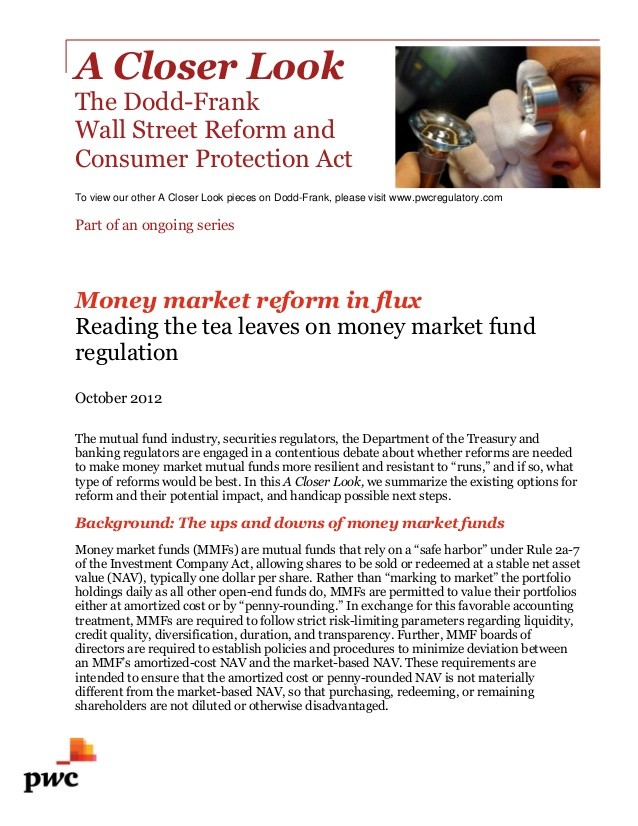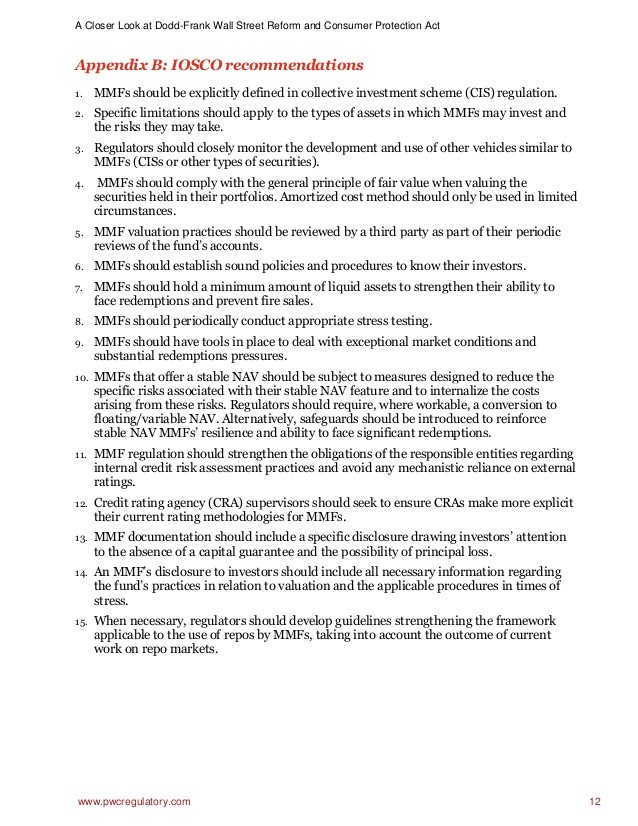In brief SEC issues final rules to reform money market funds – PwC
Post on: 6 Апрель, 2015 No Comment

At a glance
What happened?
On July 23, 2014, the SEC issued final rules aimed at reducing the risk of a run by investors on money market funds. The new rules mandate the use of a floating net asset value (NAV) for institutional prime money market funds. In addition, the rules provide boards the ability to impose liquidity fees, as well as implement redemption gates, for all non-government money market funds during periods of stress. The rules are not expected to alter the designation of money market funds as cash equivalents.
Institutional prime money market funds will be required to float their NAVs by reflecting the market-based value of the funds’ assets. The use of amortized cost and penny rounding methods to maintain a stable NAV will no longer be allowed, as these funds will be required to round NAV to the nearest basis point (i.e. the fourth decimal place). This will result in NAVs other than $1.00. Government and retail money market funds are not required to convert to a floating NAV and are still able to utilize existing methods of valuation.
Liquidity fees and redemption gates
The new rules contain provisions for the use of liquidity fees and redemption gates for all non-government money market funds. According to the new rules, when the money market funds’ “weekly liquid assets,” as defined in Rule 2a-7, fall below designated thresholds, boards may need to take specific action. The thresholds and related actions are:
- Weekly liquid assets less than 30% of total assets
- Boards are allowed to impose a liquidity fee, up to two percent of all redemptions.
- Boards are permitted to suspend redemptions temporarily, i.e. implement redemption “gates”, if deemed to be in the best interest of the fund. However, gates must not extend beyond 10 business days, and cannot be imposed for more than 10 business days within a 90-day period.
Although government funds are not subject to the new liquidity fee or gate provisions, these funds have the option to voluntarily elect these modifications.

Enhanced disclosures and other requirements
The new rules require daily website disclosure of the fund’s liquidity levels, the impositions of fees and gates, and the market-based NAV per share, among other details. In addition to the creation of Form N-CR, existing Form N-MFP (Monthly Schedule of Portfolio Holdings of Money Market Funds) and Form-PF (Reporting Form for Investment Advisers to Private Funds and Certain Commodity Pool Operators and Commodity Trading Advisors) will be amended to add additional disclosures. Finally, modifications have been made to existing diversification and stress testing requirements.
Cash equivalent assessment
The SEC noted that under normal circumstances, qualifying money market funds with floating NAVs will continue to be reported as cash equivalents. However, in the event credit or liquidity issues arise, including the increased potential for enactment of liquidity fees or redemption gates, investors will need to assess the validity of continuing to account for such money market funds as cash equivalents.
As a result of the new rules, the U.S. Department of the Treasury and the Internal Revenue Service released two new types of tax guidance, including a simplified tax accounting model for tracking gains and losses in floating NAV money market funds and a new revenue procedure aimed at providing relief from “wash sale” rules for losses incurred as a result of investments in floating NAV money market funds.
Why is this important?
The new rules reforming money market funds present fundamental operational changes, most significantly as it relates to the transition to a floating NAV and requirements surrounding liquidity fees and redemption gates. Institutional prime money market funds should expect the greatest impact as a result of the new rules, although all non-governmental funds are impacted by the new liquidity fee and gate provisions.
What’s next?
The compliance date for floating NAVs, liquidity fees, and gate amendments is two years after the date of publication of the release in the Federal Register. Compliance with the new Form N-CR is expected within nine months after the date of publication of the rules in the Federal Register, and compliance with amendments to diversification, stress testing, disclosure, Form PF, Form N-MFP and clarifying amendments is 18 months after the date of publication of the rules in the Federal Register.
Questions?
PwC clients who have questions about this In brief should contact their engagement partner. Engagement teams who have questions should contact the authors.














